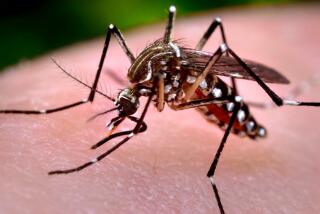Preparing for the Worst
- Share via
Any anxiety caused by the county’s showing in a drill last year testing its preparedness and defense against a biological or chemical attack should be eased somewhat by Monday’s announcement that the county plans to spend $2 million by year’s end to improve its ability to respond to an attack. But there is plenty to do.
The drill, one of the largest ever held in the nation, simulated a sarin gas attack at Edison International Field in Anaheim. Drills, of course, are held to uncover system weaknesses in preparedness and reaction. This one, according to a Department of Defense report, would have to be considered a success. It uncovered several significant shortcomings.
Although police and fire personnel responded rapidly, there were two major deficiencies--the county’s new $82-million communications system and the inability of hospitals to adequately treat large numbers of victims of a terrorist attack.
Rescue efforts in the drill were dogged by communications problems, with various agencies unable to reach one another on the county’s new radio system. Several months ago the county decided to spend another $1 million to fix bugs and improve reception. Those problems must be corrected and are not merely a persistent and costly nuisance. Efficient radio communications is a must, not only in disaster situations but for everyday police and fire operations.
The county’s hospital network was in worse shape. No one hospital has the ability to respond to mass casualties from a terrorist attack. That’s understandable. But today, even a moderate number of victims wouldn’t be getting adequate treatment.
UCI Medical Center in Orange, the county’s largest trauma center, has only enough antidotes to treat 20 patients of a biological or chemical attack. There is a critical shortage of protective suits for doctors and other medical personnel. And most hospitals have neither the ability to scrub large numbers of victims clean of chemicals nor the extra capacity to house or isolate more than a few victims at a time.
The $2 million the county agreed to spend to beef up the hospitals’ readiness can help buy more drugs and supplies and develop a coordinated plan linking hospitals together and to other emergency services. But the needs uncovered in the drill go beyond preparedness for terrorist attacks.
Health officials repeatedly remind residents that the chances of a biological or chemical assault are slim. That’s reassuring. But one emergency room physician observed that “no hospital in Orange County is prepared to deal with hundreds of people coming in all at once.” That’s disturbing.
The county doesn’t have to be subjected to a chemical attack to send hundreds of patients to hospitals seeking emergency care. A major earthquake or other disaster could do that and flood emergency rooms and tax hospital staffs and budgets that are already woefully thin.
It’s important for hospitals to increase their supply of antidotes and portable showers to react to terrorist attacks. It’s also vital for them, and the entire medical care community, to reassess the county’s capability of meeting whatever massive response it is called upon to make.
More to Read
Sign up for Essential California
The most important California stories and recommendations in your inbox every morning.
You may occasionally receive promotional content from the Los Angeles Times.













